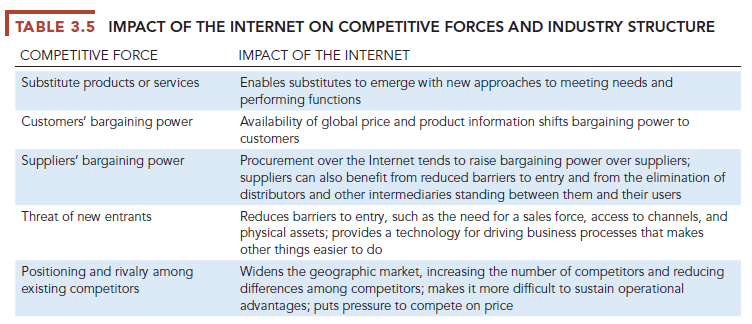Because of the Internet, the traditional competitive forces are still at work, but competitive rivalry has become much more intense (Porter, 2001). Internet technology is based on universal standards that any company can use, making it easy for rivals to compete on price alone and for new competitors to enter the market. Because information is available to everyone, the Internet raises the bargaining power of customers, who can quickly find the lowest-cost provider on the web. Profits have been dampened. Table 3.5 summarizes some of the potentially negative impacts of the Internet on business firms identified by Porter.

The Internet has nearly destroyed some industries and has severely threatened more. For instance, the printed encyclopedia industry and the travel agency industry have been nearly decimated by the availability of substitutes over the Internet. Likewise, the Internet has had a significant impact on the retail, music, book, retail brokerage, software, telecommunications, and newspaper industries.
However, the Internet has also created entirely new markets; formed the basis for thousands of new products, services, and business models; and provided new opportunities for building brands with very large and loyal customer bases. Amazon, eBay, iTunes, YouTube, Facebook, Travelocity, and Google are examples. In this sense, the Internet is “transforming” entire industries, forcing firms to change how they do business.
Smart Products and the Internet of Things
The growing use of sensors in industrial and consumer products, often called the Internet of Things (IoT), is an excellent example of how the Internet is changing competition within industries and creating new products and services. Under Armour and other sports and fitness companies are pouring money into wearable health trackers and fitness equipment that use sensors to report users’ activities to remote corporate computing centers where the data can be analyzed (see the Interactive Session on Technology). John Deere tractors are loaded with field radar, GPS transceivers, and hundreds of sensors keeping track of the equipment. GE is creating a new business helping its aircraft and wind turbine clients improve operations by examining the data generated from the many thousands of sensors in the equipment. The result is what are referred to as “smart products”—products that are a part of a larger set of information-intensive services sold by firms (Gandhi and Gervet, 2016; Porter and Heppelmann, 2014; Iansiti and Lakhani, 2014).
The impact of smart, Internet-connected products is just now being understood. Smart products offer new functionality, greater reliability, and more intense use of products while providing detailed information that can be used to improve both the products and the customer experience. They expand opportunities for product and service differentiation. When you buy a wearable digital health product, you not only get the product itself, you also get a host of services available from the manufacturer’s cloud servers. Smart products increase rivalry among firms that will either innovate or lose customers to competitors. Smart products generally raise switching costs and inhibit new entrants to a market because existing customers are trapped in the dominant firm’s software environment. Finally, smart products may decrease the power of suppliers of industrial components if, as many believe, the physical product becomes less important than the software and hardware that make it run.
Source: Laudon Kenneth C., Laudon Jane Price (2020), Management Information Systems: Managing the Digital Firm, Pearson; 16th edition.

magnificent points altogether, you just gained a logo new reader. What would you suggest in regards to your post that you simply made some days ago? Any certain?
I conceive other website proprietors should take this website as an example , very clean and good user genial style.
This website truly has all of the information I wanted concerning this subject and didn’t know who to ask.
Excellent site you have got here.. It’s hard to find quality writing like yours these days. I truly appreciate people like you! Take care!!